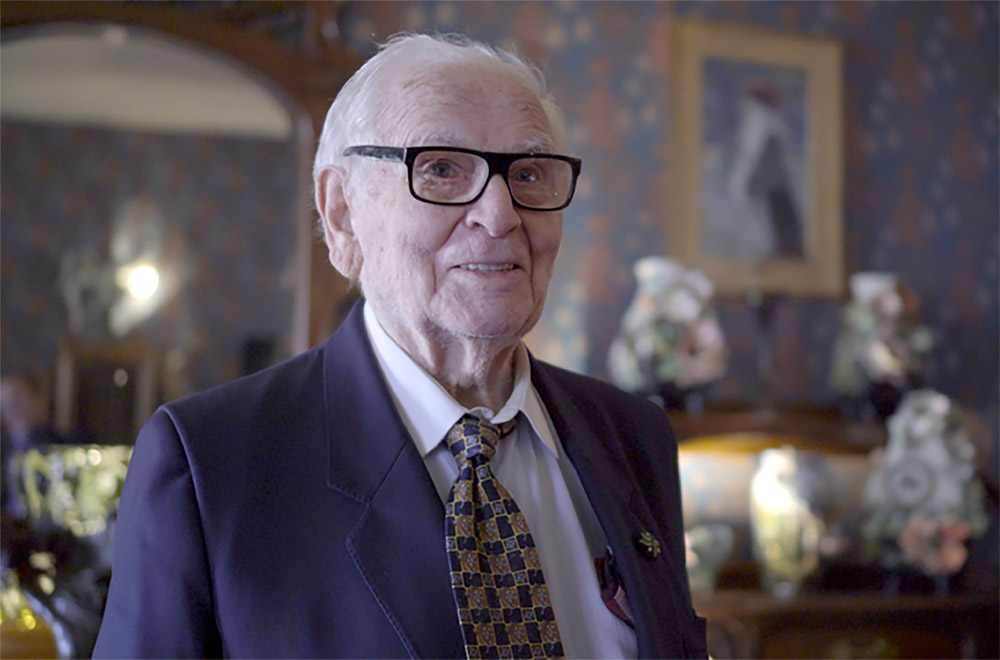“There’s no house in the world with more styles than the House of Cardin,” Pierre Cardin can be heard saying in the film named after his famed fashion line, backed up quickly by his assistant who acknowledges that she’s stopped counting. Since taking Paris by storm in the 1950s with his fine tailoring and innovative dress designs, Cardin’s luxury brand empire that began with clothes and grew into products ranging from perfume to furniture and to even his own “Espace Cardin,” where musicians and other artists could come and perform, required filmmakers who were equally adventurous in their aesthetic were its story ever to be told, which is perhaps why the designer could tell from a single look that P. David Ebersole and Todd Hughes might be up to the job.
“What Jean-Paul Gautier and Phillippe Starck said to us is what happened to us — he meets you, he reads you and he’s like yes or no,” says Hughes. “If he says yes, you’re usually with him for the rest of your life. Everyone who worked for him had a similar story and he’s clairvoyant. He really has a good sense and can just feel people.”
Mind you, Hughes and Ebersole didn’t have any plans to make a film about Cardin when they went to meet him, approaching him first as fans who counted among their collection a rare AMC Javelin, the only car to bear the designer’s imprimatur, and a circular coffee table that involved a search on social media to find that an entire Cardin universe was out there to unearth. In “House of Cardin,” they manage to pack as much of it as they can into 95 minutes, honoring the designer with a pace as brisk and confident as a model strutting on the catwalk, or simply keeping up with Cardin even now well into his eighties as remains actively engaged in the day-to-day affairs of his sprawling business. The number of different cultural spheres that Cardin has touched can be seen in the variety of people Ebersole and Hughes interview, from musicians including Alice Cooper and Dionne Warwick, who describes how the designer diversified who could be seen at the height of fashion, to fellow designers such as Guo Pei and Hanae Mori, to hardcore collectors the world over, showing how he transformed an innate skill for stitching into weaving together the kind of world he’d like to see.
Following a celebrated festival run that kicked off last year at the Venice Film Festival, “House of Cardin” is arriving this week in virtual cinemas and Ebersole and Hughes spoke about unexpectedly getting the keys to the Cardin kingdom, getting such a personal glimpse into a notoriously private person and how they made a film that was distinctive in its own right while nodding throughout to its stylish subject.
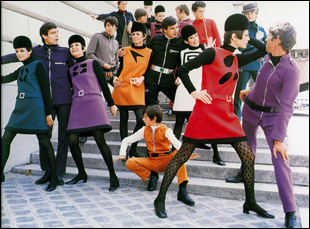
P. David Ebersole: That we are. We backed our way into a little bit through our Pierre Cardin obsession [since] we really started as people that really appreciated and loved his design and we had this opportunity to meet the man. As far as we were concerned, we were just trying to meet our design hero and get a picture for Facebook to impress our friends. But he knew that we were documentary filmmakers, or his team knew that when we met him, and before we knew it, we were all talking about making a movie together. We thought, “Oh my God, we have to take this opportunity and do it, so off we went. It was just divine intervention.
When you’re criss-crossing the Atlantic to film this over the course of a year, were there certain events you wanted to see in his life?
Todd Hughes: Well, thank God for Norwegian Air, that made going from Paris to L.A. very easy, but he was very withdrawn [initially]. Once we interviewed him, he wanted to do it again because our first interview, everyone was nervous. It was at Maxime’s with lots of crew and it all went very quickly and that was the day he said, “Come with me upstairs” and he took us upstairs and our camera guy just followed him and he walked around the Art Nouveau museum and started talking and we’re like, “Ohh, this is when he opens up.” When you put him on a chair and ask him questions…
P. David Ebersole: He’s a little more serious.
Todd Hughes: But if you let him walk around and play with his toys, you get a different man. He’s laughs and cries and by the end, he was so comfortable with us. He was really opening up.
P. David Ebersole: And we had to have translators on set. It was like in the UN [where] we had someone sitting back in another room, whispering into our ear what was being said on camera so we could ask questions and redirect and then the person that was asking questions for us would translate questions for what we said, so it was just a constant wild thing. We speak what we call “schoolgirl French” – we can kind of get by. “Where’s the bus? And how do I get to the library?” But complicated concepts of design and philosophy, we were like, “What’s going on?” and that made [sorting through the archival a challenge] that’s in French and we don’t speak French.
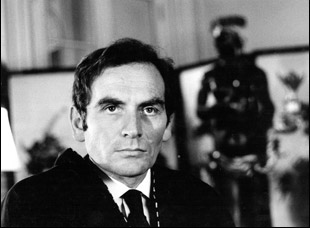
P. David Ebersole: Yeah, the movie has screened and you see something and you’re like, Oh, where was that?
Was there anything that took you in a direction you hadn’t expected?
Todd Hughes: One example of that is we were in the archives, going through the photos and we’re like, “Wow, there are a lot of pictures of Charlotte Rampling. Were they friends?” And Matthew was sitting with us and said, “Well, actually, she was married to Jean-Michel Jarre” and he and Pierre were good friends…
P. David Ebersole: And collaborators.
Todd Hughes: And we were like, “What?” The next thing we know, we’re sitting face-to-face with Jean-Michel Jarre, who is one of my heroes, and he’s saying the most brilliant things about them being futurists who had this optimistic dream of the future, not like today where the future is so dystopian. They were dreaming of a wonderful future where the whole world got along and dressed beautifully.
P. David Ebersole: Yeah, space travel meant anything was possible. So it’s the people that you interview who open the film up, more so than the archival. You do discover gems and you decide we have to put that in, like the footage of Alice Cooper performing at Espace Cardin. [We saw that] and I’m like, “We’ve got to find Alice Cooper now and interview him,” so sometimes the archival demands that you do something, but often you go into interviews — and of course, you have your questions and know you think your movie’s about to be able to even interview someone — but they always tell you things that you have no idea are coming, so you have to stay open on to that.
He’s greatly insightful before finding out that fact, but one of my favorite things about the film is not knowing why Alice Cooper is in the movie for a half-hour.
P. David Ebersole: Yeah, at the beginning, we tease him because we think people are going to be like, “Alice Cooper”?
Todd Hughes: Also, he can say “Cardin” so effortlessly.
Something I loved about the film is how you filmed the interviews and bring the environment into it. Was that something the subjects were suggesting?
P. David Ebersole: We come from a narrative background, so when we go to shoot something, we’re thinking of not just the person we’re shooting, but also the environment. One of the pet peeves that just drives me insane is seeing a documentary where people put people up against a wall. All you’ve got to do is turn the chair around and there’s a whole room behind you, so we go in like a location scout, looking for where we can film them, but it’s usually their location.
Todd Hughes: Pierre was really generous with us and said, “You can have any of my properties” and as Naomi Campbell said, “He owns half of Paris,” so we were able to film at Maxime’s [with] all those different color combos and different rooms because that place was massive. And then we had the museum at our disposal [where] we interviewed Naomi Campbell and then Sharon Stone, we used a very beautiful apartment in L.A.
P. David Ebersole: Yeah, our co-producer let us use her apartment for a couple of things and the poor girl had no idea we were going to come in with our cam crew and tear her whole place apart to keep getting new backgrounds and new location shots.
Todd Hughes: We shot four different interviews there.
P. David Ebersole: In four different ways! And you had no idea they were all in the same apartment. She was like, “I’ve never seen my house look like this before.”
Todd Hughes: But Sharon Stone would be walking out the door and Jenny Shimizu would be walking in, it was very fun.
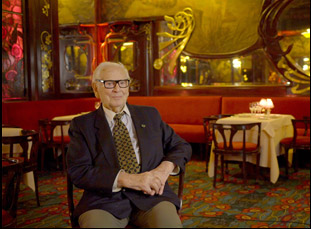
Todd Hughes: It was a real sculpture. There was so much to work with and we kept throwing it together and seeing what stuck and what didn’t. It really was a lot of playing back and forth until we got the right combination and then when it finally clicked, people say it’s like a rollercoaster. It just takes off and then it’s over and you’re like, “What just happened?”
P. David Ebersole: But that is our style. We like to entertain and really put a lot up there for people to see and experience. We love color and unique presentations of split screen and ways of bringing material across, so every one of our movies, people almost always end up telling us, “I almost feel like I have to see it again now that I know the story, just so I can look at everything.”
Todd Hughes: David Ansen said something very, very nice to us – he said, “Your style reminds me of the way Pierre’s brain must work with all these ideas going on. Visually, you feel everything going on in his head,” [which] I thought was a very nice thing to say and it’s what was happening by natural osmosis of being around him.
It’s obvious Pierre is very private about his personal life, particularly his sexuality, and you get across he really expresses himself through his work. Was that a challenge that became informative to how you could approach this?
P. David Ebersole: We stuck with the idea that it was important to talk about people that were truly important in his life, so [we weren’t interested in] delving into a string of boyfriends over the years or personal feelings and relationships that he didn’t really want to talk about, but Jeanne Moreau and Andre Oliver were the two loves of his life, so we really said we have got to cover those, even though he was reluctant about both. And he’s not like, “Oh, we can keep the gay part private, but we can talk about Jeanne Moreau,” when we asked about Jeanne Moreau, he said, “That’s a private relationship that I’d prefer not to talk about.” He didn’t tell us any subject was off-subject, but he would just shut down and not answer.
Todd Hughes: But then he told us very intimate details about his friendship with Jean Marais, the actor who’s in “Beauty and the Beast.” They were the same size and they developed quite a friendship onscreen, and you can infer what you want, but he totally outed himself too when we were asking, “Why did all these famous intellectuals of the period who were homosexuals flock around you?” And he said, “They all wanted to sleep with me.” We’re like, “Okay.” You get it. We don’t spell it out, but you can put the pieces together.
As Pierre Cardin collectors, were there items in these collections you were visiting that were revelations?
P. David Ebersole: So many things…
Todd Hughes: We just posted a picture on Instagram. In Japan, of Mr. Hatori’s collection, he had these dolls called the Cardinettes and they were like marionettes that came in this beautiful box – that was like oh my God, who knew?
P. David Ebersole: We had never seen it before. And Madame Yuri had a lot of the porcelain limoges dishes that Todd and I had been lusting after. They’re very hard to find, and you do find yourself [thinking] like, “We really do love that china, Madame Yuri…” [laughs]
Todd Hughes: Well, Mr. Hatori gave me a 45 of the Yellow Magic Orchestra that was on Les Disques Pierre Cardin in a triangular sleeve, which is very rare. And we just found out Mr. Hatori, in the film, was a movie star in the ‘50s. He was in the “Godzilla” movies and “The Three-Headed Monster” and “Destroy All Monsters.” He was in “War of the Gargantuas.” And Madame Yuri was a kabuki artist in the ‘30s.
P. David Ebersole: One review of the movie said, the Hatoris are a movie in and of themselves and we completely agree with that. We wish we could’ve just told their whole story.
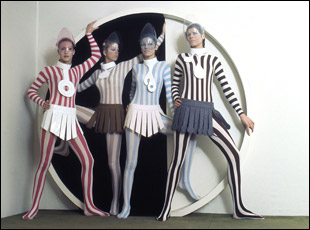
P. David Ebersole: The film festival life that we got to have was very special. It was just a dream come true to be able to premiere in Venice and have Mr. Cardin there and experience a standing ovation in his honor. Then we actually went from there to Reykavik, which is a place we always wanted to go and that was fantastic. We had the U.S. premiere in Chicago, then we went to New York and came home where we got this incredible reception in Palm Springs where we had sold out screenings and people came out all dressed up for the movie. It was like a party and we had four screenings of 400-500, 700-800 people and we got Pierre Cardin a star on the Walk of Stars here, so it was just a celebration. and then COVID hit right after. [Still] we’re actually planning a drive-in event here in Palm Springs on September 4th where people will come in their vintage cars and vintage dress and watch the movie big and outside, so that should be really fun.
Todd Hughes: [Palm Springs] is our hometown and all these people know, before we even met Pierre Cardin, they were part of our obsession and they were helping us and saying, “Oh, I saw this Pierre Cardin, do you want for me to buy it?” So for them, it was amazing because we just blew into town and then ended up meeting Pierre Cardin and then ended up basically bringing him to Palm Springs.
“House of Cardin” opens on August 28th in virtual cinemas and will be available on VOD on September 15th.




